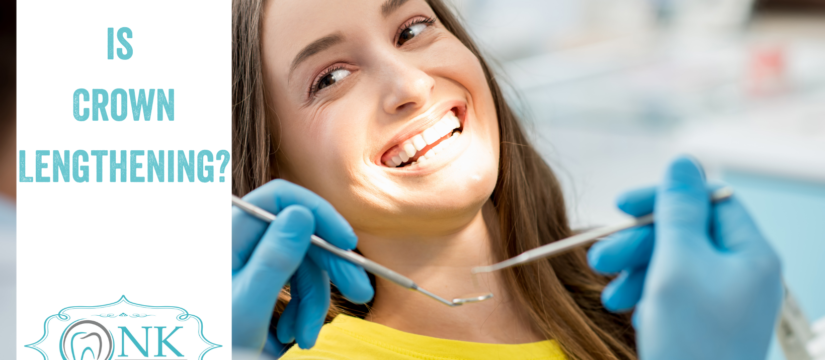
Most people are familiar with such dental restorations as crowns and bridges. However, one common procedure you may not have heard about is crown lengthening – which sometimes needs to be performed in preparation for a crown or bridge. This is both a restorative and cosmetic dental treatment that removes excess gum tissue in order to properly contour teeth. In some cases, bone tissue may also be removed to expose the tooth’s surface. It is called crown lengthening because removing gum tissue makes the crown – or visible portion of the teeth – appear longer.
To state it simply, crown lengthening adjusts the gum and bone level to expose more of the tooth so it can be restored. This procedure can be performed on a single tooth or several teeth to obtain the desired results. Crown lengthening is a type of periodontal surgery, which our blog post – “What is Periodontal Surgery” – covers in greater detail.
Why You Might Need Crown Lengthening
Your periodontist may suggest a crown lengthening procedure to support a dental crown or bridge. There are a few reasons why you may not have enough tooth for a recommended treatment:
- Your gumline extends too far along your tooth for it to receive the restorative treatment it needs (such as a crown or bridge).
- Your tooth may have broken off at the gumline and needs to be replaced.
- Your tooth structure isn’t strong enough for restoration.
- A crown has fallen off (or a filling has fallen out), and there is decay underneath.
Crown lengthening also is performed for cosmetic reasons to correct a “gummy” smile – so-called because smiling displays a large area of gum tissue, making the upper teeth appear small. In fact, the teeth are actually the typical size, but excess gum tissue partially covers them. The medical term for this condition is gingival display. Although not harmful to oral health, correcting gingival display by crown lengthening provides an aesthetically pleasing effect that displays the upper teeth without the gums being prominent. Those who feel self-conscious about their smile can benefit from the improved appearance and resulting increase in confidence this procedure can make possible.
Types of Crown Lengthening Procedures
Depending upon the purpose of crown lengthening, there are three main types of procedures. Your periodontist will base his or her recommendation upon your individual situation. The descriptions that follow are provided by Medical News Today. Keep in mind that they are provided for educational/informational purposes only, and are not intended to represent the exact course of treatment you will receive.
Gingivectomy – This is the removal of gum tissue using a scalpel, a laser or electrocautery. The patient will receive local anesthesia.
Apically repositioned flap surgery – This involves making an incision in the gums to create a flap of tissue. The periodontist then lifts the flap to remove extra tissue and possibly bone, depending on how much of the tooth they intend to expose. Next, the flap is repositioned toward the root of the tooth; stitches keep it in place as it heals. A dental dressing or bandage may be applied over the area.
Surgical extrusion – This procedure involves moving the tooth to the desired location on the gumline. A periodontist may utilize this method when a tooth is fractured beneath the gum. Stitches may be used when restabilizing the tooth. These may dissolve over time or require removal. The dentist may also use wire or a splint to anchor the tooth to the surrounding teeth.
The Recovery Process
Your periodontist will prescribe a pain reliever or recommend an over-the-counter remedy, such as acetaminophen or ibuprofen. You might experience bleeding at the surgical site after the procedure, and your teeth may be sensitive to hot and cold temperatures. The sensitivity will ease with time. Your tooth might look longer than the neighboring teeth, and if bone was removed, the tooth may feel looser.
Minor swelling and bleeding can be expected for the first few days after a crown lengthening. Your periodontist may recommend applying a cold compress to the area.
You will receive a sheet of post-surgical instructions after the procedure. Follow all instructions. Read the instructions before leaving the office, so you can ask your periodontist should you have questions. Your periodontist also will give you an after-hours or emergency phone number to call in case of complications – such as bleeding that doesn’t stop, or significant inflammation or pain.
Typical full recovery time is three months, although you can resume most normal activities after seven days. Your restoration – be it a crown or bridge – can be placed when your periodontist determines that the surgical area has completely healed.
The Take-Home Message
Crown lengthening is a proven, safe procedure for preparing teeth for restorations, as well as correcting the visual prominence of the upper gumline when smiling. Whether performed for restorative or cosmetic reasons, crown lengthening may be the option that your dentist or periodontist recommends.
We understand that the main concern you may have is cost, which is why we accept all major PPO plans for dental insurance and also offer our in-house dental plan. Please see our financing page for more information.
At NK Family Dental, it is our mission to provide the highest quality and most compassionate oral care to our Chicago patients, including both dental and periodontal services. Our dental specialists include our general dentist, Dr. Nilofer Khan, our endodontist, Dr. Sabek and our periodontist, Dr. Amir Danesh.
Dr. Danesh is a board-certified periodontist and Diplomate of the American Board of Periodontology. He has contributed to the publication of two books, as well as published over 20 papers in prestigious dental research journals.
We serve the neighborhoods of Logan Square, Bucktown, Humboldt Park, and Wicker Park with the dedication that’s earned us the reputation as the Best Dentist in Chicago!
Schedule your visit through ZocDoc, or contact us directly. We look forward to treating you soon!
